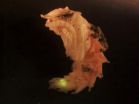(Press-News.org) DALLAS – March 19, 2014 – A UT Southwestern Medical Center study has identified a new potential therapeutic target for controlling high blood sugar, a finding that could help the estimated 25 million Americans with type 2 diabetes.
Researchers showed that lipid molecules called phosphatidic acids enhance glucose production in the liver. These findings suggest that inhibiting or reducing production of phosphatidic acids may do the opposite.
“This study establishes a role for phosphatidic acids in enhancing glucose production by the liver and identifies enzymes involved in the synthesis of phosphatidic acids as potential drug targets,” said Dr. Anil Agarwal, Professor of Internal Medicine and senior author of the study in The Journal of Biological Chemistry.
These observations were made while studying a mouse model of lipodystrophy, a rare metabolic disease in which the body is devoid of fat. Lipodystrophy patients often develop diabetes and accumulate fat in the liver because of an imbalance in the body’s ability to properly regulate lipids and glucose. The causal gene, AGPAT2, which is involved in the synthesis of phosphatidic acid and triglycerides, was removed in the mice, resulting in rodents with generalized lipodystrophy. The research team then examined what impact this genetic manipulation had on phosphatidic acids and glucose production.
“We expected the levels of phosphatidic acids to go down. However, in examining the livers of these lipodystrophic mice, we unexpectedly found high levels of this lipid class,” Dr. Agarwal said, which led to the identification of new targets involved in the production of phosphatidic acids.
The buildup of these lipid molecules was due to an increase in the levels of two enzymes in the liver, diacylglycerol kinase and phospholipase D. Researchers also discovered a marked increase in glucose production in the livers of the lipodystrophic mice.
The lack of normal insulin signaling in these lipodystrophic mice led to unrestricted production of phosphatidic acid, Dr. Agarwal explained, contributing to development of hyperglycemia, or high blood sugar.
Besides revealing a new potential therapy to test for treatment of diabetes, the study’s findings may have implications in understanding how cancer develops. Increased phosphatidic acid levels may play an important role in a metabolic pathway that supplies energy to cancer cells.
Lead author Dr. Shireesha Sankella, a postdoctoral researcher in the Division of Nutrition and Metabolic Diseases, now plans to test the inhibitors of diaclyglycerol kinase and phospholipase D in cultured cells and in animals to understand the molecular mechanisms for increased glucose production by phosphatidic acids in liver and cancer cells.
INFORMATION:
Other UT Southwestern researchers involved in the study were Dr. Abhimanyu Garg, Chief of the Division of Nutrition and Metabolic Diseases in Internal Medicine; and Dr. Jay Horton, Chief of the Division of Digestive and Liver Diseases in Internal Medicine.
This news release is available on our home page at http://www.utsouthwestern.edu/home/news/index.html
To automatically receive news releases from UT Southwestern via email, subscribe at http://www.utsouthwestern.edu/receivenews
Researchers identify potential new therapeutic target for controlling high blood sugar
2014-03-19
ELSE PRESS RELEASES FROM THIS DATE:
NASA sees ex-Tropical Cyclone Gillian affect Indonesia
2014-03-19
The remnants of former Tropical Cyclone Gillian moved out of the Southern Pacific Ocean and into the Indian Ocean only to trigger warnings and watches for part of Indonesia on March 19. NASA's Aqua satellite passed over the stubborn storm and took a visible image of the re-organizing tropical low pressure area.
NASA's Aqua satellite passed over Gillian's remnants on March 19 at 05:30 UTC/1:30 a.m. EDT and the Moderate Resolution Imaging Spectroradiometer or MODIS instrument took a visible picture of the storm. The image showed that the storm appeared to be well-defined, ...
Satellite sees newborn So. Pacific Tropical Storm Mike
2014-03-19
NOAA's GOES-West satellite caught the birth of Tropical Storm Mike in the Southern Pacific Ocean on March 19. Mike's formation has generated warnings for the Southern Cook Islands.
NOAA's GOES-West or GOES-15 satellite captured an infrared image of newborn Tropical Storm Mike in the Southwestern Pacific Ocean on March 19 at 1200 UTC/8 a.m. EDT. Mike appeared to be a compact, rounded tropical storm with bands of thunderstorms wrapping into it. NOAA's GOES-West satellite sits in a fixed orbit in space capturing visible and infrared imagery of all weather over the western ...
The scientific legacy of colonialism in Africa
2014-03-19
Colonial legacy has a significant impact on scientific productivity across the continent of Africa, according to a study by researchers at the University of Lomé, in Togo. Writing in the International Journal of Education Economics and Development, the team suggests that Africa performs relatively poorly compared with other regions of the world. Moreover, their analysis of data for the period 1994 to 2009 shows that African nations with a British colonial legacy are much more productive than countries with French or other history. This, the team adds, correlates with superior ...
French Alps Property Market Witnesses a Surge in Interest From International Buyers
2014-03-19
Demand for property in the Alps is on the increase with a growing number of foreigners looking to invest in resorts such as Chamonix, according to new figures.
Property agents in Chamonix, a resort in France's Savoie region and one of the key Alpine winter destinations, are reporting soaring property demand, much of which is being driven by the international buyers. The real estate agents also revealed an increase in property prices of more than eight per cent during 2013. This surge in interest can be attributed to the infrastructure upgrades in Chamonix and also to ...
Catching the early spread of breast cancer
2014-03-19
DALLAS, March 19, 2014 — When cancer spreads from one part of the body to another, it becomes even more deadly. It moves with stealth and can go undetected for months or years. But a new technology that uses "nano-flares" has the potential to catch these lurking, mobilized tumor cells early on. Today, scientists presented the latest advances in nano-flare technology as it applies to the detection of metastatic breast cancer cells.
The report was one of more than 10,000 at the 247th National Meeting & Exposition of the American Chemical Society (ACS). The meeting is taking ...
Noninvasive colorectal cancer screening tool shows unprecedented detection rates
2014-03-19
ROCHESTER, Minn. — March 17, 2014 — Results of a clinical trial of Cologuard show unprecedented rates of precancer and cancer detection by a noninvasive test. The detection rates are similar to those reported for colonoscopy. The results were published in the March 20 issue of the New England Journal of Medicine (NEJM). Cologuard was co-developed by Mayo Clinic and Exact Sciences.
Cologuard, is a noninvasive sDNA test for the early detection of colorectal precancer and cancer. The Cologuard test is based on a stool sample that is analyzed for DNA signatures of precancer ...
New, noninvasive, stool-based colorectal cancer screening test
2014-03-19
(New York, March 19, 2014) – A new, non-invasive, stool-based screening test detected 92% of colorectal cancer (CRC), according to a multicenter trial published online today in the New England Journal of Medicine. The new test, which is not yet approved by the FDA, allows patients to collect a sample at home without the need for bowel preparation or diet restrictions.
Unlike other available stool-based CRC screening tests, which rely solely on detecting occult blood in the stool, this new test, called "Cologuard", developed and patented by Exact Sciences, detects both ...
Work shines light on Hox genes responsible for firefly lantern development
2014-03-19
It's difficult to identify a single evolutionary novelty in the animal kingdom that has fascinated and intrigued mankind more than the lantern of the firefly. Yet to this day, nothing has been known about the genetic foundation for the formation and evolution of this luminescent structure.
But now, new work from a former Indiana University Bloomington graduate student and his IU Ph.D. advisor offers for the first time a characterization of the developmental genetic basis of this spectacular morphological novelty -- the firefly's photic organ -- and the means by which this ...
Winners and losers in globalization of world's economy, health and education
2014-03-19
Globalization has made the world a better and more equal place for many more people than was the case a few decades ago. However, it has also created two well-defined worlds of poor countries and wealthy nations, according to Vanesa Jordá and José María Sarabia of the University of Cantabria in Spain. In an article published in Springer's journal Applied Research in Quality of Life, they studied the distribution of well-being over the last wave of globalization between 1980 and 2011.
Well-being is generally described as the state of being happy, healthy or prosperous. ...
Magnetic behavior discovery could advance nuclear fusion
2014-03-19
ANN ARBOR—Inspired by the space physics behind solar flares and the aurora, a team of researchers from the University of Michigan and Princeton has uncovered a new kind of magnetic behavior that could help make nuclear fusion reactions easier to start.
Fusion is widely considered the ultimate goal of nuclear energy. While fission leaves behind radioactive waste that must be stored safely, fusion generates helium, a harmless element that is becoming scarce. Just 250 kilograms of fusion fuel can match the energy production of 2.7 million tons of coal.
Unfortunately, it ...




